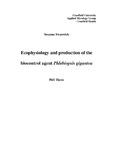JavaScript is disabled for your browser. Some features of this site may not work without it.
| dc.contributor.advisor | Magan, Naresh | |
| dc.contributor.advisor | Aldred, David | |
| dc.contributor.author | Swanwick , Susanne | |
| dc.date.accessioned | 2008-08-18T15:26:02Z | |
| dc.date.available | 2008-08-18T15:26:02Z | |
| dc.date.issued | 2007 | |
| dc.identifier.uri | http://hdl.handle.net/1826/2928 | |
| dc.description.abstract | Heterobasidion annosum, the causative agent of the disease “root and butt rot” in conifers, is ubiquitous in the environment and causes severe financial losses to the forestry industry throughout the temperate zone. The normal route of infection is as basidiospores that land on the freshly cut stump surface during thinning operations, the colonisation of the stump providing sufficient inoculum for the fungal hyphae to invade healthy roots of adjoining trees. The most successful disease control measures involve depriving the pathogen the opportunity to become established in the food source of the fresh cut stump. Frequently killing the surface of the stump with a chemical treatment does this, but there is also some success with a biocontrol method. When the antagonist Phlebiopsis gigantea, a saprophyte, is inoculated onto the stump surface it rapidly invades the tissue thus preventing the pathogen access to the resource. Environmental studies have been carried out to assess the fitness of different isolates of the antagonist relative to the pathogen. Competitiveness was affected by environmental factors; water availability, osmotic/matric potentials, temperature, nutrition, and substrate. These indicate that the antagonist is not able to suppress the pathogen under all conditions. Generally, in wet warm conditions the antagonist is dominant, ID 10:2 antagonist:pathogen, but in drier, cooler conditions the pathogen is dominant, ID 2:10 on MEA. Interactions in situ on wood discs showed the pathogen was restricted to 0-2% of the treated portion and 2-10% of the un-treated surface at 25 ºC, but at 4 ºC it colonised 2-24% of the former and 34-57% the latter. Consideration needs to be given to possible field conditions at the time of application to maximise the establishment of the antagonist. Studies have been carried out to examine potential for liquid or solid substrate fermentation systems for optimising production of P.gigantea. Liquid culture studies were variable regardless of available nutrients and ecophysiological stresses imposed, producing a maximum of 6.5 log10 CFU ml -1 . However, temporal studies on solid substrate based on Pinus sylvestris sawdust gave 8 Log10 viable oidia g -1 in the best moisture content treatments. Scale up, to 200g substrate produced similar CFUs, however increasing to 400 g showed a reduction in viable oidia, due to lack of moisture equiibration. Analyses of the endogenous reserves to identify specific quality characteristics were inconclusive. Mycelial pellets and submerged conidia produced in fermentation had increased levels of glycerol and erythritol as aw was lowered, however this was not replicated by oidia produced in solid substrate fermentation. Preservation studies, in a fluidised bed reactor showed, the survival of PG21 spores at up to 60 ºC for 20 min. Studies were carried out to analyse volatile fingerprints of antagonist and pathogen isolates using an AlphaM.O.S. electronic nose. Volatile fingerprints showed clear grouping of antagonist and pathogen isolates, as distinct from each other. With some isolates, the fingerprints of interactions were co-incidental with the antagonist. It is suggested that this novel technique could be used as a rapid screening method for potential BCAs. | en_UK |
| dc.language.iso | en | en_UK |
| dc.publisher | Cranfield University | en_UK |
| dc.rights | © Cranfield University 2007. All rights reserved. No part of this publication may be reproduced without the written permission of the copyright owner. | en_UK |
| dc.title | Ecophysiology and production of the biocontrol agent Phlebiopsis gigantea | en_UK |
| dc.type | Thesis or dissertation | en_UK |
| dc.type.qualificationlevel | Doctoral | en_UK |
| dc.type.qualificationname | PhD | en_UK |
